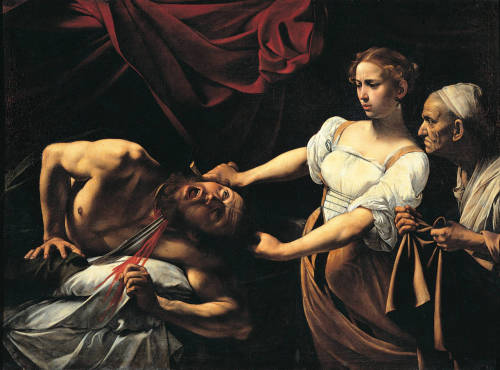The first painting, Judith Beheading Holophernes, was completed by Caravaggio in 1598. The execution is flawless and the composition is appealing despite the relative calmness of it all.
The second painting, Judith Slaying Holophernes, 1611, was done by a woman painter of the same era, Artemisia Gentileschi, who must have seen Caravaggio's and decided she could perhaps add something to the story.
Gentileschi's re-interpretation of the story has improved it greatly and kicked the former's two-dimensional keyster.
The Judith in Caravaggio's piece seems to be quite squeamish: she is intent on leaning as far away as she can to avoid bloodstaining her dress. The poor dear's worried look on her brow seems to convey that she's uneasy about having to do this despite the fact that General Holophernes and his Assyrian army have come to destroy her city and home. The maid behind her has an appropriately disgusted look on her face but is still only passively waiting to receive Holophernes' noggin. Picking it apart further, the spurting blood looks caricatured, as if ridiculous strings of yarn were attached to the model while he was posing for the artist.What begins to dawn on the viewer is the possibility that the painting was conceived from the vantage point of Holophernes-- as if the story was all about him and his fleeting pain.
Gentileschi's Judith becomes much more capable; this is the story about Judith.
(Oh, snap, someone is beheading me...)
Gentileschi's re-interpretation of the story has improved it greatly and kicked the former's two-dimensional keyster.
The Judith in Caravaggio's piece seems to be quite squeamish: she is intent on leaning as far away as she can to avoid bloodstaining her dress. The poor dear's worried look on her brow seems to convey that she's uneasy about having to do this despite the fact that General Holophernes and his Assyrian army have come to destroy her city and home. The maid behind her has an appropriately disgusted look on her face but is still only passively waiting to receive Holophernes' noggin. Picking it apart further, the spurting blood looks caricatured, as if ridiculous strings of yarn were attached to the model while he was posing for the artist.What begins to dawn on the viewer is the possibility that the painting was conceived from the vantage point of Holophernes-- as if the story was all about him and his fleeting pain.
Gentileschi's Judith becomes much more capable; this is the story about Judith.
Take note: This is how you do it.
Notice that the composition is much more dynamic and the postures of all characters much more believable. This is a powerfully competent widowed queen (look at those arms!) who is used to taking care of business and she has chosen her staff to support her in whatever needs to be done. The maid has jumped in to help restrain him because there is going to be a struggle (why wouldn't there be??) and they are not going to be deterred, dammit. Even the blood looks more believable.
It is important for an artist to build into the composition the postures and expressions that best exemplify the characters and their story. We're not always given all of the details of the story, so we must extrapolate the information. What would the character really have endured? What might have been going through her/his head? How might s/he truly and realistically behaved? Putting oneself into the shoes of the character based on one's own experience might be what's needed.

